Yogesh Balaji
A Comprehensive Study of Decoder-Only LLMs for Text-to-Image Generation
Jun 09, 2025Abstract:Both text-to-image generation and large language models (LLMs) have made significant advancements. However, many text-to-image models still employ the somewhat outdated T5 and CLIP as their text encoders. In this work, we investigate the effectiveness of using modern decoder-only LLMs as text encoders for text-to-image diffusion models. We build a standardized training and evaluation pipeline that allows us to isolate and evaluate the effect of different text embeddings. We train a total of 27 text-to-image models with 12 different text encoders to analyze the critical aspects of LLMs that could impact text-to-image generation, including the approaches to extract embeddings, different LLMs variants, and model sizes. Our experiments reveal that the de facto way of using last-layer embeddings as conditioning leads to inferior performance. Instead, we explore embeddings from various layers and find that using layer-normalized averaging across all layers significantly improves alignment with complex prompts. Most LLMs with this conditioning outperform the baseline T5 model, showing enhanced performance in advanced visio-linguistic reasoning skills.
Cosmos World Foundation Model Platform for Physical AI
Jan 07, 2025



Abstract:Physical AI needs to be trained digitally first. It needs a digital twin of itself, the policy model, and a digital twin of the world, the world model. In this paper, we present the Cosmos World Foundation Model Platform to help developers build customized world models for their Physical AI setups. We position a world foundation model as a general-purpose world model that can be fine-tuned into customized world models for downstream applications. Our platform covers a video curation pipeline, pre-trained world foundation models, examples of post-training of pre-trained world foundation models, and video tokenizers. To help Physical AI builders solve the most critical problems of our society, we make our platform open-source and our models open-weight with permissive licenses available via https://github.com/NVIDIA/Cosmos.
Edify Image: High-Quality Image Generation with Pixel Space Laplacian Diffusion Models
Nov 11, 2024Abstract:We introduce Edify Image, a family of diffusion models capable of generating photorealistic image content with pixel-perfect accuracy. Edify Image utilizes cascaded pixel-space diffusion models trained using a novel Laplacian diffusion process, in which image signals at different frequency bands are attenuated at varying rates. Edify Image supports a wide range of applications, including text-to-image synthesis, 4K upsampling, ControlNets, 360 HDR panorama generation, and finetuning for image customization.
One-Step Diffusion Policy: Fast Visuomotor Policies via Diffusion Distillation
Oct 28, 2024



Abstract:Diffusion models, praised for their success in generative tasks, are increasingly being applied to robotics, demonstrating exceptional performance in behavior cloning. However, their slow generation process stemming from iterative denoising steps poses a challenge for real-time applications in resource-constrained robotics setups and dynamically changing environments. In this paper, we introduce the One-Step Diffusion Policy (OneDP), a novel approach that distills knowledge from pre-trained diffusion policies into a single-step action generator, significantly accelerating response times for robotic control tasks. We ensure the distilled generator closely aligns with the original policy distribution by minimizing the Kullback-Leibler (KL) divergence along the diffusion chain, requiring only $2\%$-$10\%$ additional pre-training cost for convergence. We evaluated OneDP on 6 challenging simulation tasks as well as 4 self-designed real-world tasks using the Franka robot. The results demonstrate that OneDP not only achieves state-of-the-art success rates but also delivers an order-of-magnitude improvement in inference speed, boosting action prediction frequency from 1.5 Hz to 62 Hz, establishing its potential for dynamic and computationally constrained robotic applications. We share the project page at https://research.nvidia.com/labs/dir/onedp/.
JeDi: Joint-Image Diffusion Models for Finetuning-Free Personalized Text-to-Image Generation
Jul 08, 2024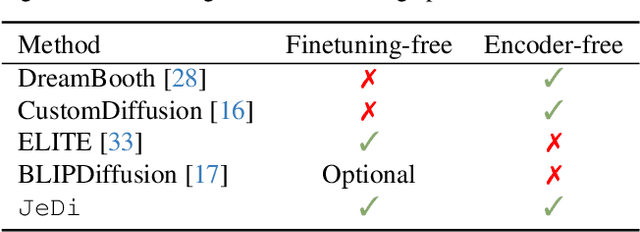
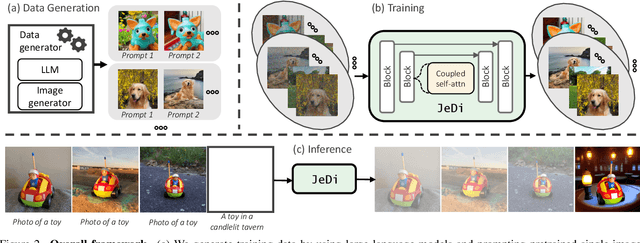

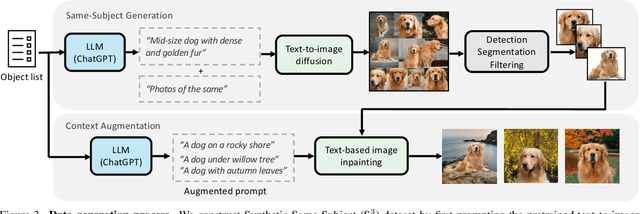
Abstract:Personalized text-to-image generation models enable users to create images that depict their individual possessions in diverse scenes, finding applications in various domains. To achieve the personalization capability, existing methods rely on finetuning a text-to-image foundation model on a user's custom dataset, which can be non-trivial for general users, resource-intensive, and time-consuming. Despite attempts to develop finetuning-free methods, their generation quality is much lower compared to their finetuning counterparts. In this paper, we propose Joint-Image Diffusion (\jedi), an effective technique for learning a finetuning-free personalization model. Our key idea is to learn the joint distribution of multiple related text-image pairs that share a common subject. To facilitate learning, we propose a scalable synthetic dataset generation technique. Once trained, our model enables fast and easy personalization at test time by simply using reference images as input during the sampling process. Our approach does not require any expensive optimization process or additional modules and can faithfully preserve the identity represented by any number of reference images. Experimental results show that our model achieves state-of-the-art generation quality, both quantitatively and qualitatively, significantly outperforming both the prior finetuning-based and finetuning-free personalization baselines.
Preserve Your Own Correlation: A Noise Prior for Video Diffusion Models
May 17, 2023Abstract:Despite tremendous progress in generating high-quality images using diffusion models, synthesizing a sequence of animated frames that are both photorealistic and temporally coherent is still in its infancy. While off-the-shelf billion-scale datasets for image generation are available, collecting similar video data of the same scale is still challenging. Also, training a video diffusion model is computationally much more expensive than its image counterpart. In this work, we explore finetuning a pretrained image diffusion model with video data as a practical solution for the video synthesis task. We find that naively extending the image noise prior to video noise prior in video diffusion leads to sub-optimal performance. Our carefully designed video noise prior leads to substantially better performance. Extensive experimental validation shows that our model, Preserve Your Own Correlation (PYoCo), attains SOTA zero-shot text-to-video results on the UCF-101 and MSR-VTT benchmarks. It also achieves SOTA video generation quality on the small-scale UCF-101 benchmark with a $10\times$ smaller model using significantly less computation than the prior art.
eDiff-I: Text-to-Image Diffusion Models with an Ensemble of Expert Denoisers
Nov 17, 2022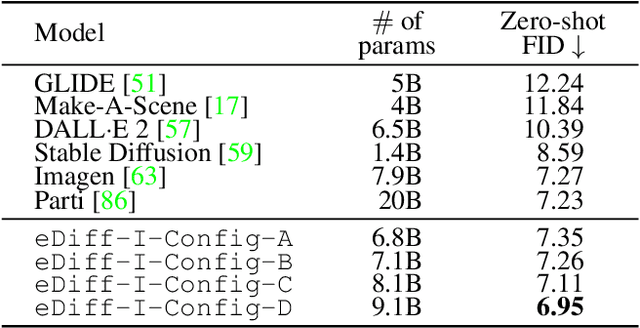

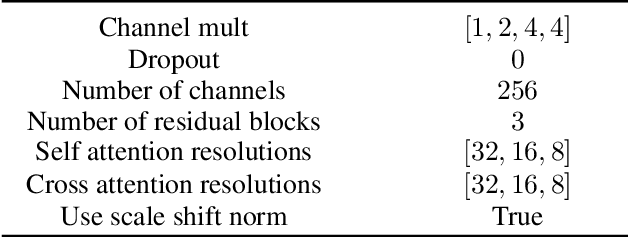

Abstract:Large-scale diffusion-based generative models have led to breakthroughs in text-conditioned high-resolution image synthesis. Starting from random noise, such text-to-image diffusion models gradually synthesize images in an iterative fashion while conditioning on text prompts. We find that their synthesis behavior qualitatively changes throughout this process: Early in sampling, generation strongly relies on the text prompt to generate text-aligned content, while later, the text conditioning is almost entirely ignored. This suggests that sharing model parameters throughout the entire generation process may not be ideal. Therefore, in contrast to existing works, we propose to train an ensemble of text-to-image diffusion models specialized for different synthesis stages. To maintain training efficiency, we initially train a single model, which is then split into specialized models that are trained for the specific stages of the iterative generation process. Our ensemble of diffusion models, called eDiff-I, results in improved text alignment while maintaining the same inference computation cost and preserving high visual quality, outperforming previous large-scale text-to-image diffusion models on the standard benchmark. In addition, we train our model to exploit a variety of embeddings for conditioning, including the T5 text, CLIP text, and CLIP image embeddings. We show that these different embeddings lead to different behaviors. Notably, the CLIP image embedding allows an intuitive way of transferring the style of a reference image to the target text-to-image output. Lastly, we show a technique that enables eDiff-I's "paint-with-words" capability. A user can select the word in the input text and paint it in a canvas to control the output, which is very handy for crafting the desired image in mind. The project page is available at https://deepimagination.cc/eDiff-I/
A Comprehensive Study of Image Classification Model Sensitivity to Foregrounds, Backgrounds, and Visual Attributes
Jan 26, 2022
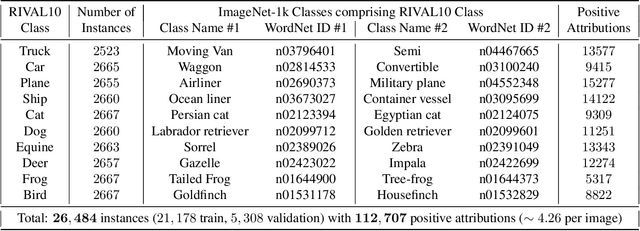
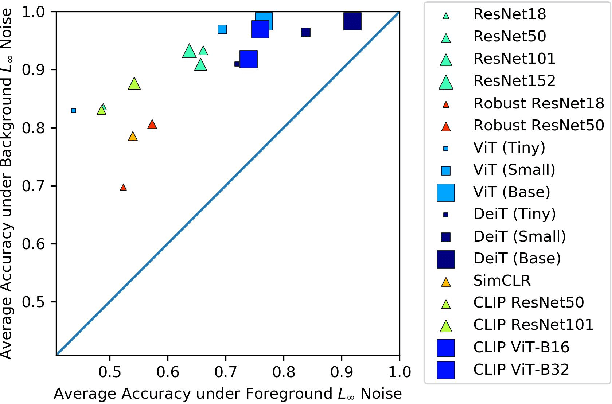

Abstract:While datasets with single-label supervision have propelled rapid advances in image classification, additional annotations are necessary in order to quantitatively assess how models make predictions. To this end, for a subset of ImageNet samples, we collect segmentation masks for the entire object and $18$ informative attributes. We call this dataset RIVAL10 (RIch Visual Attributes with Localization), consisting of roughly $26k$ instances over $10$ classes. Using RIVAL10, we evaluate the sensitivity of a broad set of models to noise corruptions in foregrounds, backgrounds and attributes. In our analysis, we consider diverse state-of-the-art architectures (ResNets, Transformers) and training procedures (CLIP, SimCLR, DeiT, Adversarial Training). We find that, somewhat surprisingly, in ResNets, adversarial training makes models more sensitive to the background compared to foreground than standard training. Similarly, contrastively-trained models also have lower relative foreground sensitivity in both transformers and ResNets. Lastly, we observe intriguing adaptive abilities of transformers to increase relative foreground sensitivity as corruption level increases. Using saliency methods, we automatically discover spurious features that drive the background sensitivity of models and assess alignment of saliency maps with foregrounds. Finally, we quantitatively study the attribution problem for neural features by comparing feature saliency with ground-truth localization of semantic attributes.
Understanding Overparameterization in Generative Adversarial Networks
Apr 12, 2021

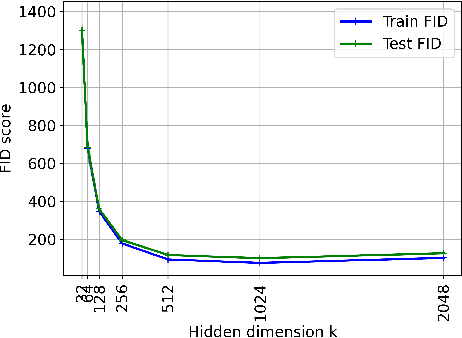
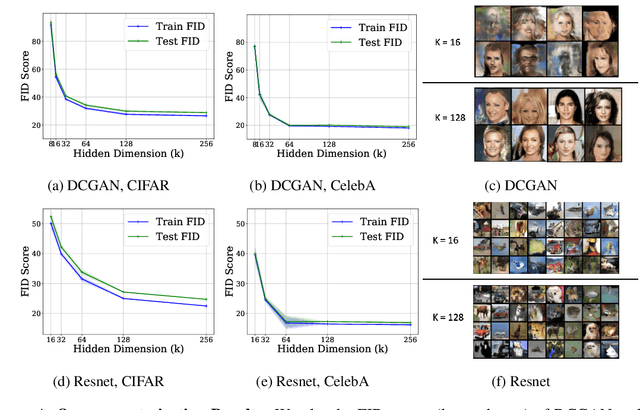
Abstract:A broad class of unsupervised deep learning methods such as Generative Adversarial Networks (GANs) involve training of overparameterized models where the number of parameters of the model exceeds a certain threshold. A large body of work in supervised learning have shown the importance of model overparameterization in the convergence of the gradient descent (GD) to globally optimal solutions. In contrast, the unsupervised setting and GANs in particular involve non-convex concave mini-max optimization problems that are often trained using Gradient Descent/Ascent (GDA). The role and benefits of model overparameterization in the convergence of GDA to a global saddle point in non-convex concave problems is far less understood. In this work, we present a comprehensive analysis of the importance of model overparameterization in GANs both theoretically and empirically. We theoretically show that in an overparameterized GAN model with a $1$-layer neural network generator and a linear discriminator, GDA converges to a global saddle point of the underlying non-convex concave min-max problem. To the best of our knowledge, this is the first result for global convergence of GDA in such settings. Our theory is based on a more general result that holds for a broader class of nonlinear generators and discriminators that obey certain assumptions (including deeper generators and random feature discriminators). We also empirically study the role of model overparameterization in GANs using several large-scale experiments on CIFAR-10 and Celeb-A datasets. Our experiments show that overparameterization improves the quality of generated samples across various model architectures and datasets. Remarkably, we observe that overparameterization leads to faster and more stable convergence behavior of GDA across the board.
Robust Optimal Transport with Applications in Generative Modeling and Domain Adaptation
Oct 12, 2020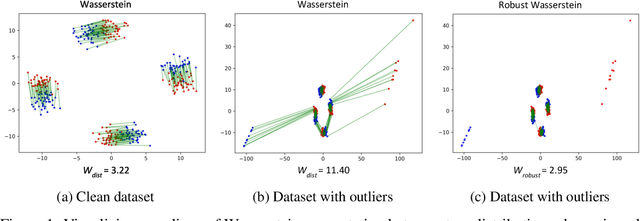


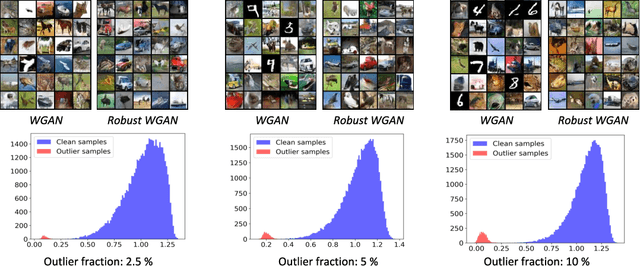
Abstract:Optimal Transport (OT) distances such as Wasserstein have been used in several areas such as GANs and domain adaptation. OT, however, is very sensitive to outliers (samples with large noise) in the data since in its objective function, every sample, including outliers, is weighed similarly due to the marginal constraints. To remedy this issue, robust formulations of OT with unbalanced marginal constraints have previously been proposed. However, employing these methods in deep learning problems such as GANs and domain adaptation is challenging due to the instability of their dual optimization solvers. In this paper, we resolve these issues by deriving a computationally-efficient dual form of the robust OT optimization that is amenable to modern deep learning applications. We demonstrate the effectiveness of our formulation in two applications of GANs and domain adaptation. Our approach can train state-of-the-art GAN models on noisy datasets corrupted with outlier distributions. In particular, our optimization computes weights for training samples reflecting how difficult it is for those samples to be generated in the model. In domain adaptation, our robust OT formulation leads to improved accuracy compared to the standard adversarial adaptation methods. Our code is available at https://github.com/yogeshbalaji/robustOT.
 Add to Chrome
Add to Chrome Add to Firefox
Add to Firefox Add to Edge
Add to Edge